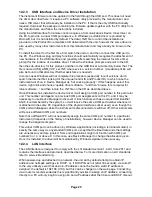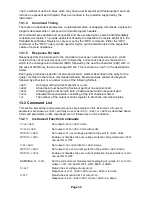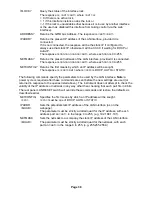
Page 33
13
Remote Commands (MX180TP only)
13.1 General
13.1.1
Remote and Local Operation
At power-on the instrument will be in the local state, with normal keyboard operation possible.
All remote interfaces are active and listening for a remote command. When any command is
received from any interface the instrument will enter the remote state. In this state the keyboard
is locked out, the display switches to the home screen, with REM displayed in the upper right
corner. The instrument may be returned to the local state by pressing the LOCAL key; however
the remote state will be immediately re-entered if the instrument is addressed again or receives
another command from any interface. It is the responsibility of the user to avoid any conflict if
parameters are changed from the front panel while in the local state.
13.1.2
Remote Command Handling
Each remote control interface has a separate input queue which is filled, under interrupt, in a
manner transparent to all other instrument operations. The RS232 interface implements flow
control by sending XOFF when the queue contains approximately 200 characters, and then
XON when about 100 free spaces become available. All the other interfaces have standard
automatic flow control mechanisms built into their physical layer communication protocol.
Commands are taken from the input queues by the parser as available. Commands and queries
from each queue are executed in order, but the order of execution of commands from different
interfaces is not defined and should not be relied upon. It is strongly recommended that use
should be made of the interface locking facilities described above. The parser will not start a
new command until any previous command or query is complete. Responses are sent to the
interface which issued the query. There is no internal output queue, so on the GPIB interface
the response formatter will wait, indefinitely if necessary, until the complete response message
has been read by the controller, before the parser is allowed to start the next command in the
input queue. On all other interfaces the response message is immediately sent into buffers in
the physical layer.
13.1.3
Remote Command Formats
Commands are sent as <
PROGRAM MESSAGES
> by the controller, each consisting of zero or more
<
PROGRAM MESSAGE UNIT
> elements, separated (if there is more than one such element) by
<
PROGRAM MESSAGE UNIT SEPARATOR
> elements, and finally a <
PROGRAM MESSAGE TERMINATOR
>.
The <
PROGRAM MESSAGE UNIT SEPARATOR
> is the semi-colon character '
;
' (3BH).
The <
PROGRAM MESSAGE TERMINATOR
>, which separates or terminates <
PROGRAM MESSAGES
>, is
the new line character (0AH), but in the case of the GPIB interface the hardware END message
may also be used, either with the last character of the message or with the new line. In the case
of the LAN interface, commands may not be split across TCP/IP packet boundaries.
A <
PROGRAM MESSAGE UNIT
> is any of the commands in the remote commands list, which must
be sent in full as specified. A command must be separated from any parameters by <
WHITE
SPACE
> (which is defined as the character codes 00H to 20H inclusive, excluding the new line
character 0AH). No <
WHITE SPACE
>
is permitted within any command identifier or parameter, but
any other additional <
WHITE SPACE
>
is ignored. Note that the Backspace character (07H) is
treated as <
WHITE SPACE
>, so it cannot be used to delete incorrect characters, and will not hide
the error.
The high bit of all characters is ignored and all commands are case insensitive. Commands that
require a numeric a parameter accept the free form <
NRF
> format; text parameters must be sent
as Character Program Data <
CPD
> as specified.











































